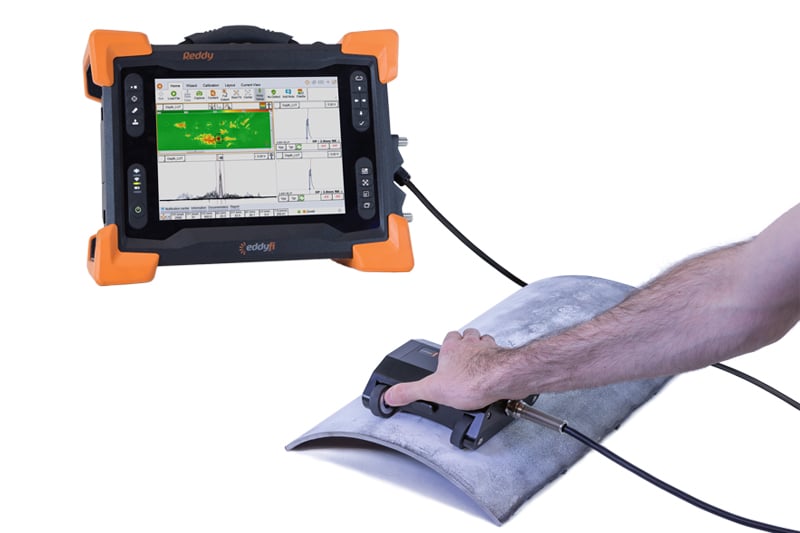10 Things You Need To Know When Choosing An Eddy Current Array (ECA) Surface Probe
The evolution of Eddy Current Array (ECA) electromagnetic technology has made it possible to inspect large surfaces and sub-surfaces of various components for flaws and defects.
Image Source: Eddyfi Technologies
The evolution of Eddy Current Array (ECA) electromagnetic technology has made it possible to inspect large surfaces and sub-surfaces of various components for flaws and defects. It maintains high resolution whilst inspecting large areas in a single pass, making it a ‘go-to’ method for a wide range of industries looking for fast and reliable inspections which have a high probability of detection.
If you are using or considering buying or hiring an eddy current array surface probe, you’ll be interested in the following essential information. Here are 10 things you ought to know about the technology and how to use it for optimum results:
- Where can an ECA probe be used?
It’s important to know the exact characteristics of the surface under test as each one has its own specific electromagnetic properties. The configuration of the ECA probe depends on the unique properties of the material and accuracy is essential in order to achieve optimum inspection results. For example, stainless steels don’t all have the same characteristics. 400-series stainless is ferromagnetic whilst 300-series isn’t and just to complicate matters, there are exceptions in each of those categories! Not knowing what material is being tested can affect your inspection results.
Although it’s not as important to know the thickness of the material under test and whether it has been cast or machined or treated in any way (either mechanically, thermally or chemically), it is nonetheless worthwhile establishing this information upfront as it may have an impact on the material properties.
- What’s the environment like?
Different mechanical designs of ECA probes are suited to different environments. Knowing where your probe will be used and understanding the challenges (eg dusty, marine, radioactive, corrosive) will help you make the right choice of instrument.
- Understand the shape of the surface being tested.
Determine the level of flexibility required for your probe before you start by obtaining a clear picture of the shape of the surface under test. Streamline and speed up the inspection process by using CAD technology to determine whether the surface is flat or curved, what the bend radius is and whether it has an unusual shape.
- Be clear on the type of flaw you’re looking for.
For optimum results, you need to match the way the coils are arranged and activated within the probe as well as the inspection frequencies and topology with the type of defect that you’re looking for. The set up will be different for different defects eg pitting, stress corrosion, cracking, porosity and general corrosion, so you need to be precise about your target.
- What size flaws are you looking for?
In order to ensure that your inspection technology is appropriate for the task, you need to be clear on the size of the defect that you would typically expect to find. This is important because whilst a high-resolution ECA probe can pick up very small flaws, the surface condition or the method of operation of the device may not give you the appropriate coverage or desired resolution.
- Where are flaws located?
An ECA surface probe can be optimised to get the best level of penetration and coverage, so it’s important to know the approximate position of the defects in the material under test so as to determine the right operational frequencies and topology.
- What’s the orientation of the flaws?
The orientation of the flaw in relation to the direction of the scan is a crucial factor in determining the suitability of ECA technology. Not all devices are well suited to detecting cracks that run parallel to the scans whilst others aren’t ideal for locating cracks which run perpendicular to the scans.
- Determine the condition of the area being tested.
The type of contact interface of the ECA surface probe depends on the surface conditions. Surface conditions (eg rusty, rough, contaminated) also dictate the level of durability required by the probe as well as the minimum size of the flaws that can be detected. For example, if the surface is very rough or uneven, it can be difficult to locate very small defects and compromises may have to be made.
- Accessibility
The shape of the probe and the need for various accessories will be dictated by the location of the area under test. If access is challenging (eg it is very high up, has large gaps in between or there are structural interferences), you may need additional resources.
- Understand the specifications/limitations of your test instrument
The tester and ECA surface probe need to be compatible, so get to know the model and number of channels available on your tester.
The right information makes the process of finding the right ECA probe for your specific inspection needs much easier and quicker. However, any professional technical equipment supplier should be asking these types of questions anyway in order to get an in-depth understanding of your needs and requirements before making any recommendations.
To find out more about Eddy Current Array technology, contact the industry experts at Nexxis for a comprehensive range of off-the-shelf or customised ECA probes and accessories.
